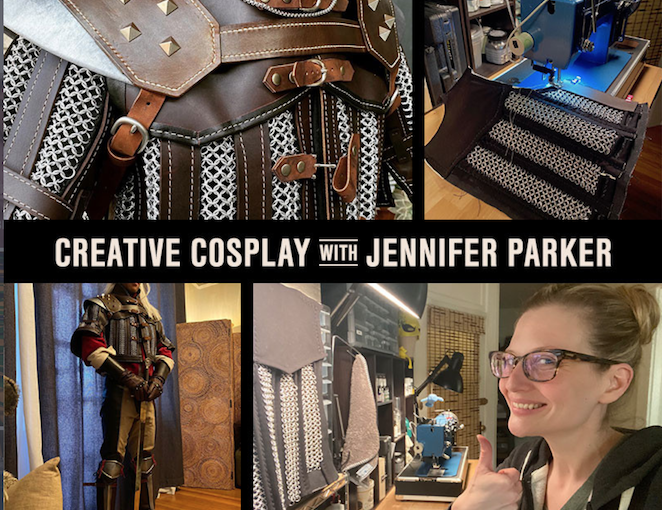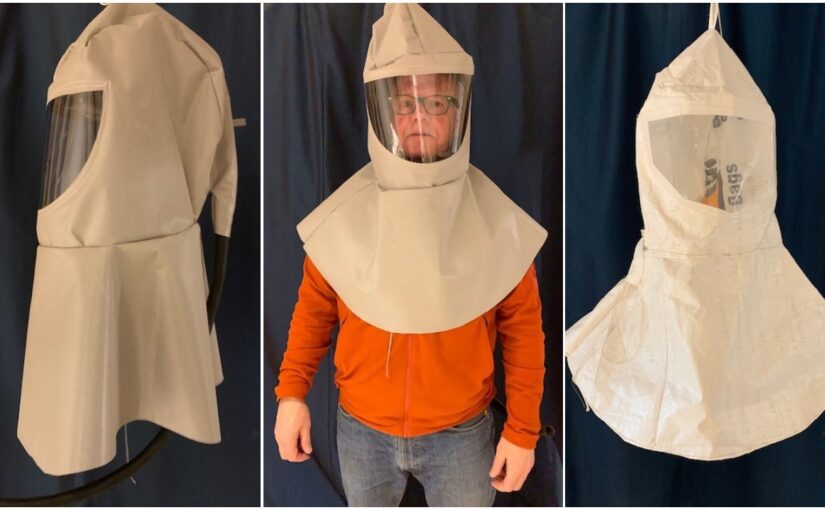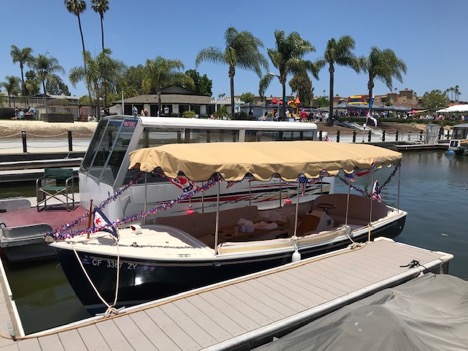Brimming with a can-do attitude and an innovative spirit, Jennifer Parker has always been a fan of the arts. From an early age, she was actively participating in local theater productions and soon found herself enamored with the costumes. Her pursuit of creative expression eventually led her to Sailrite® and the Ultrafeed® LSZ Sewing Machine. Jennifer was kind enough to share her incredible DIY journey with us and explain how Sailrite became a small, yet crucial, facet of her unique artistic endeavors.
In an effort to expand her artistic ability, Jennifer began teaching herself leatherworking as a way to recreate the costume of a beloved video game character. The results were just the start of her journey into cosplay! “I started teaching myself leatherworking three years ago, simply because I was interested in making a cosplay of the character Ciri from “The Witcher 3: Wild Hunt,” a visually gorgeous video game. They designed a strong, skilled, smart and capable heroine with a handful of awesome outfits and I thought, ‘Yep, I want to make that.’ Buying all the pieces was going to be crazy expensive, so I sought to learn how to do it myself.”
By the time the project was done, Jennifer had enough motivation to tackle another project, then another and then another. Before long she had created several costumes that featured bags, sword sheaths, belts, corsets and more. With her experience and confidence growing, she eventually decided to do the leather accessories for a Captain America costume for her husband. This meant sewing gaiters, a utility belt, gloves and a shoulder harness.

Soon after that, Jennifer realized she would need a high-quality sewing machine to sew through the myriad of materials used in her costumes. Living in a one bedroom apartment at the time meant that her sewing space was limited and a portable machine was a must-have. While there were many household and light fabric projects on her radar, the machine in question also had to be equipped to sew through the occasional thick pieces of leather used in cosplay attire. But could there possibly be an industrial sewing machine out there that didn’t require a large, stationary setup and was versatile enough to meet Jennifer’s needs?
“I started doing research and came across leatherworkers who were recommending the Sailrite Ultrafeed Sewing Machine as a very versatile option. I went to the website and was immediately hooked by the entire culture and history. My dad was a sailing instructor before he moved into the aviation industry, so I have a very strong foundation in maritime culture and fond childhood memories of learning how to sail. So not only did this machine have everything I needed, it was beautiful and affordable and I thought, ‘Well, this is a perfect fit in every way!’”
The Stitcher Becomes The Witcher
With her new machine in tow, Jennifer began making boot covers and emblems, journal covers, dog collars and even Christmas ornaments. With those projects under her belt, she once again decided to delve into the wonderful world of custom costumes. Everything she had learned up until that point would prepare her for her most complex project yet (and the one she is most proud of to date). She was going to create an exact replica of the costume for the main protagonist, Geralt, in “The Witcher” video game series and Netflix show of the same title.

“I dusted off my costuming skills and wrote a production schedule for myself — including not only the insanely complex armored jacket, but also all the accessories, velvet jacket, linen shirt, leather and chino pants, boot covers, and all the leather straps that attach his armor throughout. Planning, engineering, patterning and constructing every single garment had its challenges. I used a total of three machines, but the Ultrafeed (whom I have affectionately christened ‘Big Blue’) made her mark somewhere on them all, and exclusively on the armored jacket. It was so much more difficult than I expected. Creating something real and wearable from a rendering is immensely challenging. I found entire weekends completely scrapped because something I tried simply did not work out — more than once!”
We’re endlessly impressed by Jennifer’s dedication to her work and her patience to make sure every last detail was perfect, even the most minute ones. She went on to explain, “The jacket took nearly two weeks just to plan and over 100 hours to build. It weighs over 10 pounds, is fully lined, fully adjustable, and features removable rerebraces (sleeves) and armored mantle top piece. I used 20 square feet of five different leathers, 4 yards of canvas, 2 yards of cotton pique, 2 yards cotton batting, 5,000 aluminum chainmail jump rings, 2 pounds of hardware (rivets, snaps, buckles, spikes), 5mm foam for pauldrons and over 700 yards of nylon thread.”
Jennifer’s hard work speaks for itself and has garnered attention on Instagram and the admiration of friends and family. It’s certainly caught our eye! But for this creative connoisseur, the journey is just as important as the destination. “The most rewarding thing about all this has been discovering an art form that I love — and watching each project yield measurable progress in my overall craftsmanship.”
Future Forward
Now that she’s taken her sewing skills to the next level, what advice would Jennifer give to someone ready to start their DIY journey? She was eager to share with us. “Start small and just jump in and do something. I got some leather and basic starter supplies to start and just rolled with it until I was sure I wanted more from the hobby. I watched HUNDREDS of YouTube videos on everything from saddle-making to foam-smithing and worked on scraps while I watched. I spent a day playing with my machine, seeing exactly what it could do. Make friends with your tools and you will get to know their limitations. I talk to myself A LOT and have different playlists (and alcohol pairings) for every mood and project.”

“You will feel like your first project is totally awful. You’re going to make mistakes and do things inefficiently and take the long way and get super frustrated. In the end, you may not even be ‘doing it right’ but who cares because look at what you’ve just made! Just like anything, to become good, it takes study and practice — years of it.”
We can’t wait to see what you sew next, Jennifer!
Who We Are
Sailrite is your one-stop DIY shop! We are a passionate crew of do-it-yourselfers who strive to equip you with the supplies and how-to knowledge you need to tackle your next project. Do you want to learn upholstery, leatherwork, canvaswork, hobby sewing, bag making or more? We have the fabric, tools, hardware, sewing machines and notions you need to master any DIY. And even if you’ve never sewn before, our tutorials and how-to videos are designed for beginners and experienced crafters alike.
Start your DIY journey today: www.sailrite.com










